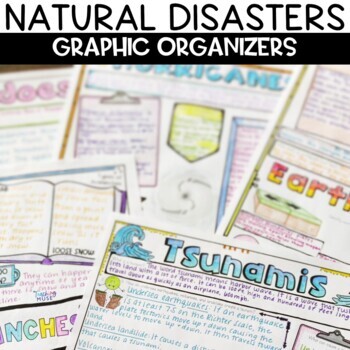Natural Disasters Activities
- Zip

What educators are saying
Products in this Bundle (5)
Bonus
Description
Review natural disasters using these graphic organizers to reinforce and review wild weather concepts relating to earthquakes, hurricanes, tornadoes, tsunamis, and volcanoes. Students will demonstrate their knowledge of a natural disaster, how natural disasters form, where and when they occur, and warning and safety measures in each activity.
Like this natural disasters activity bundle? Check out my natural disaster unit and save over 20%
Students will learn:
- what each natural disaster is
- how disasters form
- where and when they happen
- warning systems
- safety measures
Each natural disaster activity includes:
- "How to Use" sheet for your classroom
- Student instruction sheet
- Graphic organizer note sheet
- Answer key
- Model example
This natural disaster activity reviews:
- What an earthquake is
- How earthquakes happen
- Essential vocabulary terms: epicenter, fault lines, focus, and plate tectonics
- What they look like
- When and where they occur - Ring of Fire
- Frequency
- Plate boundaries: convergent, divergent, and transform
- How they are measured: seismograph, Richter scale
- Warning systems
- Safety measures
This extreme weather activity reviews:
- What is a hurricane, and what makes it so destructive
- The four stages: Tropical disturbance, tropical depression, tropical storm, and hurricane.
- The parts: eye, eyewall, and rain bands.
- Explain how one forms.
- Hurricanes frequency
- When and where they occur.
- Safety measures
- Measurement system
- Fun facts
This wild weather phenomenon reviews:
- What a tornado is
- How tornadoes form
- What they look like
- When and where they occur
- Frequency
- How they are measured
- Warning systems
This natural disaster activity reviews:
- What a tsunami is
- Causes and triggers
- What tsunamis look like
- When and where they occur - Ring of Fire
- Frequency
- Warning systems
This natural disaster activity reviews:
- What a volcano is
- How it forms
- What volcanoes look like
- Four types: cinder cone, composite, shield, and lava
- Where they occur - Ring of Fire
- Hazards created from an eruption; flowing lava, tephra, pyroclastic flow, and lahars
- Tectonic plates
- Other natural disasters they trigger such as mudslides, avalanches, tsunamis, and flash floods.
- Warning systems
- Safety precautions
This extreme weather phenomenon reviews:
- What is an avalanche
- Types of avalanches; slab and loose snow
- How often do they happen
- Causes
- Where they happen
- Risk and measurement scales
- Precautions and ways to stay safe
Ways to use these natural disaster activities in your classroom:
- As a cumulative review of natural disasters
- To summarize student knowledge of natural disasters
- Students can complete the sheet to present to the class as a natural disaster project
Teacher feedback:
- My students loved using this resource to learn about natural disasters. It helps them to remember what they have learned.
- These are a great structure to guide notetaking for students. If you hand them a blank page, some try to either copy down the entire book/internet article ... or they write down nothing at all. There's space enough for some differentiation and individuality with these as well.
- My students loved working with this resource to help them when we were working on our unit of study about natural disasters. I love the layout of this resource it made the students feel comfortable to use, and parents liked the design, layout, and how easy it was to use.
- Sent this home as part of a packet with scaffolded notes students and I completed together over zoom. It supports the Natural Hazards section in my NGSS curriculum, which discusses volcanoes, earthquakes, and severe weather hazards. We had just finished ESS standards, and this dovetailed nicely with the tectonics lesson we had just done.
NGSS MS - ESS3
NGSS 4 - ESS3
Other lessons and activities to support your unit on natural disasters:
Kindly Note: If you have questions, do not hesitate to email me at Teaching Muse Email
PLEASE PREVIEW BEFORE PURCHASING
__________________________________________________________________
Thank you for visiting Teaching Muse. I would love for you to become a follower.
Teaching Muse followers receive new product information and discounts on any new items!
__________________________________________________________________
All rights reserved by Teaching Muse. This product is to be used by the original downloader ONLY. Copying for more than one teacher, classroom, department, school, or school system is prohibited. Additionally, this product may not be distributed or displayed digitally for public view. Failure to comply is a copyright infringement and violates the Digital Millennium Copyright Act (DMCA). They are intended for classroom and personal use ONLY.





